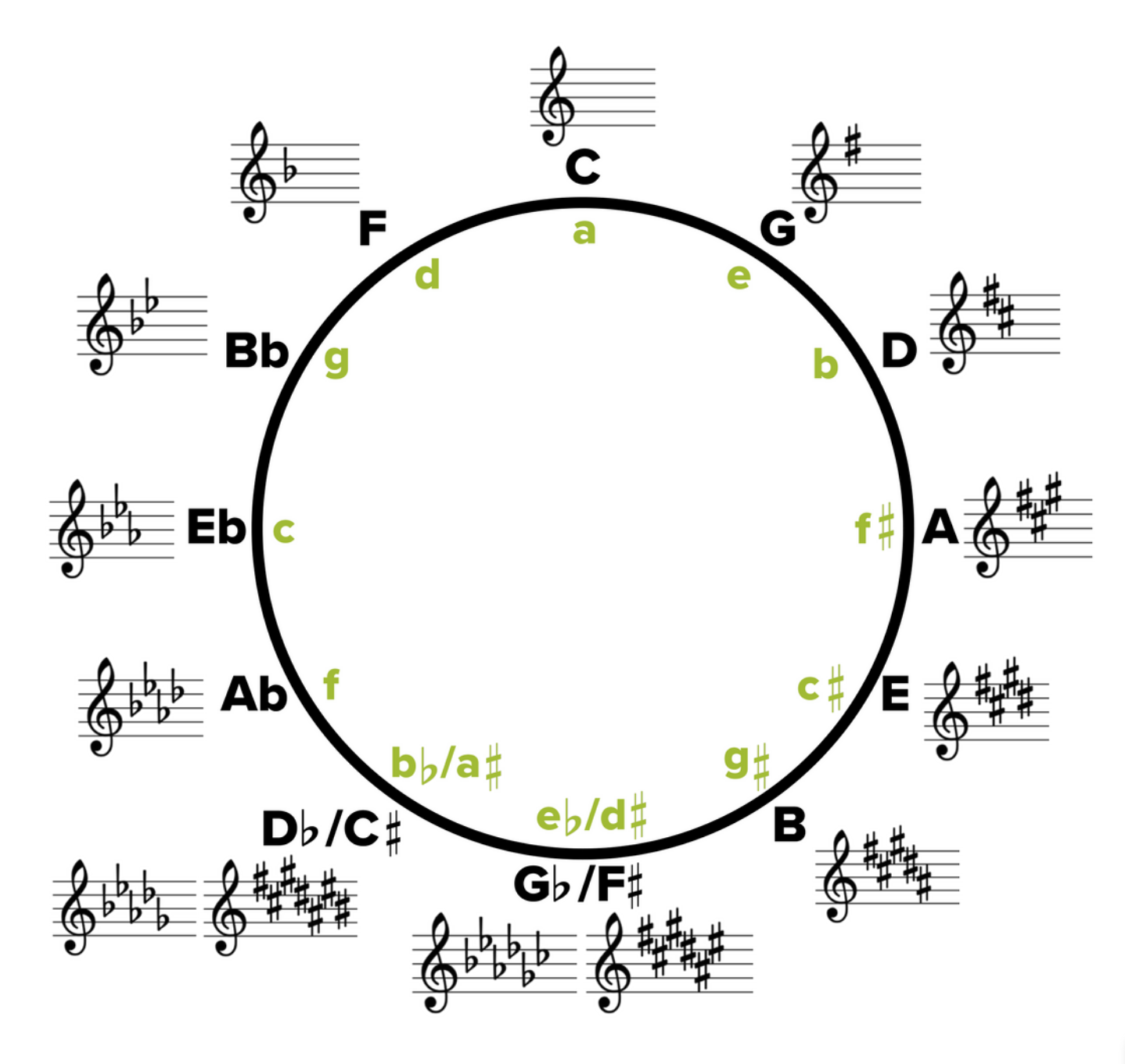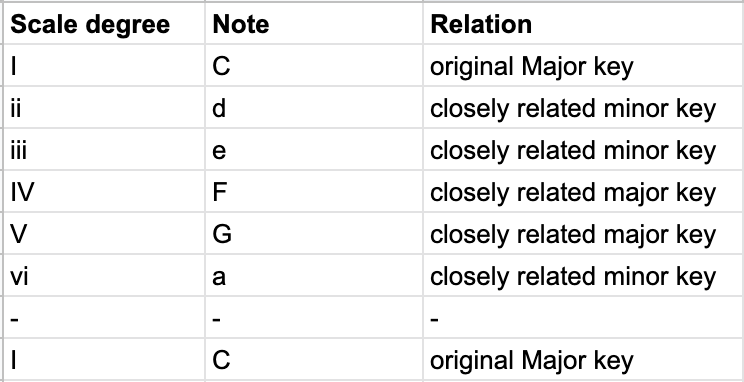2.3 Key Relationships: Parallel, Closely Related, and Distantly Related Keys
6 min read•june 18, 2024
Mickey Hansen
AP Music Theory 🎶
72 resourcesSee Units
When we relate various keys to one another, there are several different relationships that we look for.

We already talked about relative key relationships in Unit 2.1 and 2.2 but there are several others that will help us identify how and why one musical piece can shift between several keys.
Parallel Keys
Parallel keys are musical keys that have the same tonic, or root pitch, but are written in different modes. For example, the key of C major and the key of C minor are parallel keys, because they both have C as their tonic pitch.
In general, there are two pairs of parallel keys: major and minor, and dorian and mixolydian. The major and minor keys are considered parallel because they share the same tonic pitch and have a similar tonal structure, with the major key being characterized by a brighter, more joyful sound and the minor key by a darker, more introspective sound. The dorian and mixolydian keys are also considered parallel because they share the same tonic pitch and have a similar modal structure, with the dorian mode being characterized by a minor tonality and the mixolydian mode by a dominant tonality.
If you don't quite know what dorian and mixolydian modes are yet, that's totally okay! We'll learn about these in Unit 8. However, many music theory textbooks actually begin by teaching students about these modes, so we've included them to help draw connections between the modes and what we're learning now.
Parallel keys are often used in music to create smooth transitions between different sections of a piece, or to create contrast and variety.
For example, a composer might use parallel keys to transition between the verse and the chorus of a song, or between different movements of a piece of classical music. By using parallel keys, the composer can create a sense of continuity and cohesiveness, while still maintaining some musical variety.
Parallel keys can also be used to create contrast between different sections of a piece. For example, a composer might use a major key for a joyful, upbeat section and then switch to the parallel minor key for a more introspective, melancholy section. This can add interest and emotion to the music and help to create a dynamic narrative structure.
Here are the parallel keys d minor and D Major.

Closely Related Keys
Believe it or not, even though D Major and d minor have the same tonic, they are not closely related at all! What does it mean when we say that keys are closely related?
Closely related keys are musical keys that are closely related harmonically, meaning that they share many of the same pitches and chord progressions. These keys are often used in music to create smooth transitions between different sections of a piece.
There are several pairs of closely related keys:
- Relative keys: Relative keys are keys that share the same key signature, meaning they have the same pitches, but have a different tonic, or root pitch. For example, the key of C major and the key of A minor are relative keys.
- Dominant and subdominant keys: The dominant and subdominant keys are keys that are a perfect fifth apart. For example, the key of G is the dominant key of C, and the key of F is the subdominant key of C.
- Tonic and dominant keys: The tonic and dominant keys are keys that are a perfect fourth apart. For example, the key of F is the dominant key of Bb, and the key of Bb is the tonic key of F.
Here's another way to think about closely related keys. First, a key that is next to another on the circle can show us whether a key is closely related or not. There are 5 closely related keys for each key signature. Look down at the key of A Major. Let's find all 5!
We can see that its relative minor is f# minor. A key can be both a relative key AND closely related. What are the major keys on either side of A major? One is D Major. The other is E major. What are the relative minor keys of the major keys which just found? The relative minor of D Major is b minor. What is the relative minor of E Major? C# minor.

Note that a closely related key signature is only one accidental away from the original key. In the example we used before, A Major has three sharps, D Major has two, and E Major has four. Take the relative minor keys of the adjacent keys, and we add up the relative keys again to a total of 5.
The last way to find closely related keys is by scale degrees. By building keys off of every note in the scale (except from the 7th scale degree), you can find your closely related keys. Let's take an example in the key of C minor.

Distantly Related Keys
As for the distantly related keys, if they don't fall into being closely related, then you've found them! They would be considered to be located further away on the circle of fifths.

Distantly related keys are musical keys that are not closely related harmonically, meaning that they do not share many of the same chords and progressions. These keys are often used in music to create contrast and dissonance, and can be used to create a sense of tension and resolution in a piece.
There are several pairs of distantly related keys:
- Keys that are a tritone apart: Keys that are a tritone apart are keys that are six half steps apart, and have no pitches in common. For example, the key of C and the key of F# are a tritone apart.
- Keys that are a major second apart: Keys that are a major second apart are keys that are two half steps apart, and have only one pitch in common. For example, the key of C and the key of D are a major second apart.
- Keys that are a major sixth apart: Keys that are a major sixth apart are keys that are nine half steps apart, and have only one pitch in common. For example, the key of C and the key of A are a major sixth apart.
Modulating to a distantly related key can create a sense of dissonance and instability in a piece of music, and can be used to create a sense of tension and resolution. It is a useful technique for composers and can help to create a dynamic and expressive musical narrative.
🦜 Polly wants a progress tracker: Which keys are closely related to F# Major? Which are distantly related to Bb minor?
Introduction to Modulation
Modulation is the process of changing from one key to another in music. It is an important aspect of tonal music and is used to create variety, contrast, and interest in a piece.
Modulating to a closely related key can create a sense of continuity and cohesiveness in a piece of music, while still maintaining some musical variety. It is a useful technique for composers and can help to create a dynamic and expressive musical narrative.
Usually, if we want to modulate to a distantly related key, we will go through the circle of fifths to get to whichever key we want to get to. Often, we do this when we are trying to modulate between parallel keys (.e.g. d minor to D Major). However, some more modern composers, like Rachmaninov, will just modulate without using closely related keys.
This sounds sudden and dissonant, and it is an artistic choice used to create tension and surprise. However, it is not recommended to do this when you are first learning modulation!
Browse Study Guides By Unit
🎵Unit 1 – Music Fundamentals I (Pitch, Major Scales and Key Signatures, Rhythm, Meter, and Expressive Elements)
🎶Unit 2 – Music Fundamentals II (Minor Scales and Key Signatures, Melody, Timbre, and Texture)
🎻Unit 3 – Music Fundamentals III (Triads and Seventh Chords)
🎹Unit 4 – Harmony and Voice Leading I (Chord Function, Cadence, and Phrase)
🎸Unit 5: Harmony and Voice Leading II: Chord Progressions and Predominant Function
🎺Unit 6 – Harmony and Voice Leading III (Embellishments, Motives, and Melodic Devices)
🎤Unit 7 – Harmony and Voice Leading IV (Secondary Function)
🎷Unit 8 – Modes & Form
🧐Exam Skills
📚Study Tools

Fiveable
Resources
© 2025 Fiveable Inc. All rights reserved.